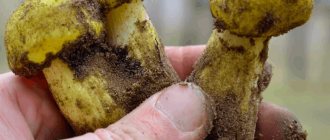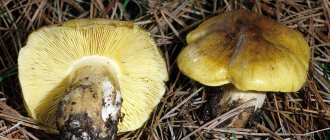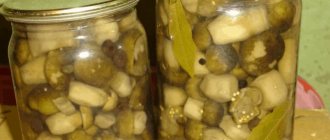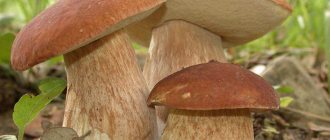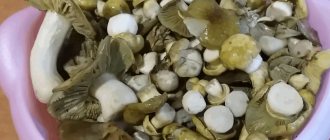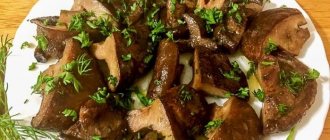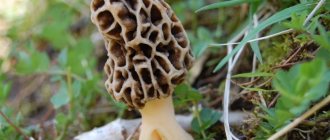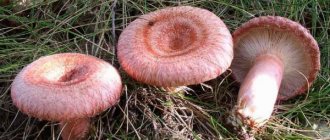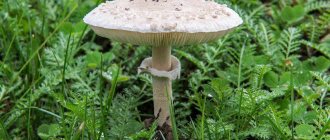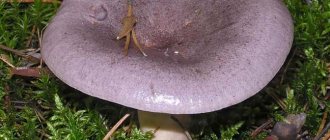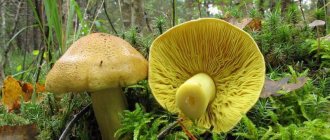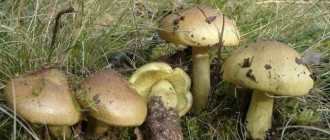Greenfinch mushrooms: photo and description
These edible mushrooms are nicknamed green mushrooms because of their characteristic green color, which remains even after cooking and pickling.
Many people are scared off by this poisonous color, but green flowers are quite a useful product. By their appearance, green mushrooms can be easily distinguished from gray mushrooms and other mushrooms. The cap of young rows is smooth, with a small tubercle in the center. The younger the mushroom, the lighter the color of its cap. Experienced mushroom pickers know how to determine how long a row has been growing. In young mushrooms, the cap is colored in yellow-olive tones, in mature ones it is more saturated and dark. There are sometimes brown spots in the middle of the cap. The edges of the cap can be either raised up or down.
When the mushroom is broken, white flesh is visible. The plates on the back of the cap are thin and frequent. The stem of the row is somewhat lighter than the cap and is often hidden in the ground. Greenfinch is quite rarely wormy, and there is practically no taste. The same goes for smell. It is barely perceptible and resembles the smell of cucumber or flour.
When cutting a greenfinch, hold its base. It is better to immediately cut off the stem with adhering soil and throw it away; be sure to clean the mushrooms. It is also necessary to clean the cap, carefully separating the leaves and needles with a knife.
How to distinguish greenfinch from false, inedible mushrooms?
In appearance, the greenfinch is similar to several other species of this family. For example, with chamois row, a poisonous mushroom that causes mild gastrointestinal disorders. Therefore, it is important to be able to distinguish between edible and poisonous varieties.
The mushrooms have a similar color (yellow-green, yellowish) and cap diameter. In order not to confuse them and not expose yourself to danger, you should know the differences between species: sulfur row always has a rich, unpleasant odor, reminiscent of the smell of tar and hydrogen sulfide. It has few plates; they are always attached to the stem, which reaches up to 11 cm in height. As they age, little mice, as the gray mouse is also called, acquire a rusty or brown color.
The other two inedible species with which greenfinch can easily be confused are the sultry row and the solitary row. You can recognize them like this:
- The sultry row has a sharp, unpleasant smell and taste, and is also smaller in size.
- The isolated row is characterized by a sharply unpleasant odor and bitter taste, and has white or yellowish-tinged plates that are not as densely spaced as those of greenfinch.
Dangerous false doubles
Poisonous greenfinch imitator:
- Sulfur row (Latin name: Tricholoma sulphureum) - has a smaller size, bright sulfur-lemon color, yellow flesh, bitter taste and bad odor. Grows in coniferous and deciduous groves in July–October.
Sulfur row
Inedible lookalikes:
- Separated row (lat. Tricholoma sejunctum) - it has rarer plates than the golden row, yellowish or white. The pulp is bitter.
- Sultry row (lat.Tricholoma aestuans) is a smaller fruit with a bad smell and taste.
Spruce row
Separate row
Podzelenka is also similar to some of its brethren, ranging from mildly poisonous to edible. This:
Pointed row (lat. Tricholoma virgatum) is a poisonous mushroom with a thinner, ash-colored cap with a mound in the center. The plates are grayish in tone. The pulp is hot to taste.
Soap row (lat. Tricholoma saponaceum) is an inedible species. It has a more uniform color and no fibrousness. Smells strongly of laundry soap.
The different row (lat. Tricholoma sejunctum) is conditionally edible. The leg can be white, chestnut, green. The pulp has a bad smell.
Tricholoma terreum (lat. Tricholoma terreum) is an edible species. Significantly smaller in size. The surface of the cap is fibrous and scaly. The plates are rarer, steel-colored.
Hot way
To prepare a delicious snack for the winter, you will need this recipe for pickling greenfinch mushrooms:
- mushrooms - 2 kg;
- water - 4 glasses;
- vegetable oil;
- salt - 100 g.
How to salt green mushrooms:
- Clean the green rows well. Rinse them and drain excess liquid through a sieve.
- Bring the water in a saucepan to a boil and add salt.
- Cook the greens for 20-25 minutes over low heat. Skim off the foam constantly.
- Place mushrooms in jars.
- Pour 3 tablespoons of boiled vegetable oil into each container. Let the mushrooms cool.
- Tie the blanks with parchment paper and a tourniquet. Place in a cool room.
Preliminary preparation at home
As a rule, the preparatory stage before pickling mushrooms is a complex, long process that requires patience. It includes sorting (if you collected different types of mushrooms, and not just green stuff), clearing forest debris and washing.
- Sorting. It is better to divide all collected mushrooms by type. This is due to the fact that the time required for salting may differ for different types of fruiting bodies.
- Cleansing. The greenfinches are freed from dirt and the damaged areas are cut out with a knife. Cleaned mushrooms are washed in cold water. Don’t forget to thoroughly wash the middle recesses of the caps, as hard-to-reach dirt and debris accumulate there.
HELP : If you plan to cut large specimens, this can be done already during cleaning, then the work will be more convenient and easier.
Cold pickling of greenflowers
Salting green rows in a cold way is an excellent option for a holiday snack. To prepare mushrooms this way, you will need a suitable container: a wooden barrel, an enamel bucket or a saucepan. You can also use ceramic cookware.
- brilliant greens - 5 kg;
- salt -200 g;
- dill - 7 umbrellas;
- bay leaves - 5 pcs.;
- black currant leaves.
How to pickle green mushrooms - step-by-step description:
- Remove the film from the mushroom caps with a knife.
- Cut off most of the stem.
- Rinse the mushrooms thoroughly with water.
- Place currant leaves, dill umbrellas and salt in jars.
- Place the greens in containers, alternating them with layers of salt and dill.
- Add currant leaves to the jars and press down all the ingredients thoroughly.
- Fold the gauze several times and cover the jars with it. Place a bend on top.
- After 6 days, a brine forms in the jars. Place the mushroom preparations in a cool, dark place for storage.
After 40-50 days, mushroom pickling can be served. Complete the pickles with pickled or sauerkraut, pour over aromatic oil - an excellent treat is ready!
Description
Salting earrings is a labor-intensive and time-consuming process, but the finished product is worth it. And if you don’t know how to pickle earrings at home, right here and now we will lift the veil of secrecy for you. How to pickle mushrooms correctly, what preliminary preparation is needed, how much salt to use and how to close the jars - you will learn about all this from our step-by-step recipe with photos.
The instructions are extensive and detailed. It is prepared so that you can pickle the earrings in a cold way, and they will not become moldy. There is only one correct cooking method, and it is its secrets that we are ready to share with you today. Of course, you can add spices, bay leaves or other herbs to your pickles if you wish. However, it is believed that salting earrings is best in their pure form. After all, you are not preparing pickling for the taste of spices, but for the sake of the mushrooms themselves.
Let's start pickling mushrooms using the cold method!
Category: pen stroke 03
Greenfinch (Tricholoma equestre) is a mushroom belonging to the family. It owes its name to its green color, which persists even after any heat treatment. This is probably why it is also called zelenka or green row. These mushrooms are rich in vitamins B, PP, D, carotene, phosphorus, amino acids, fatty acids, and carbohydrates. These substances are easily digestible and beneficial for the human body.
We suggest you read: How to soak green buckwheat overnight
Serushka (Lactarius flexuosus) is a mushroom belonging to the Russula family. Popularly it is also called gray milkweed, gray-purple milk mushroom, sowthorn, plantain or traveler. It has a unique balanced chemical composition. Thanks to this, its use helps nourish the brain, strengthen the immune system and blood vessels, and remove heavy metal salts. In folk medicine, earrings are used to treat diseases of the skin and stomach.
Useful properties and calorie content
The green row contains amino acids, fatty substances, and carbohydrates, which are almost 100% absorbed by the body. Protein digestibility is up to 80%. Vitamins of group B, PP, and phosphorus are of considerable value. The calorie content of green row is only 22 kcal per 100 grams of product.
Important! Too many eaten rows can lead to poisoning. Also, people with reduced blood clotting should not eat greenberries.
Classic recipe for pickling for the winter in jars
To pickle greens in the classic way, you will need the following ingredients:
- freshly picked greens – 1 kg;
- water – 2 liters;
- salt – 40 g;
- sugar – 25 g;
- several sprigs of dried dill;
- raspberry leaves – 8 pcs.;
- cherry leaves – 8 pcs.;
- black pepper – 10 pcs.;
- bay leaf – 3 pcs.;
- vinegar – 50 ml.
We suggest you familiarize yourself with a homemade fruit picker with quick-change attachments.
How to pickle greenfinch mushrooms for the winter:
- First, you should properly prepare the rows for preservation: thoroughly rinse and clean the greenbushes.
- To prepare mushrooms for the winter, you need to make a brine. Add the required amount of spices and salt to the water and place the pan on medium heat.
- Bring to a boil and turn off the heat.
- Let the brine cool for 15 minutes.
- Next, transfer the prepared peeled greens into jars, compacting them tightly. Mushrooms should take up more than half the container.
- Pour in some brine and add more rows on top.
- Add the remaining marinade to the top of the jar. Pickled green mushrooms are immediately covered with lids and stored in a warm place for several weeks.
Characteristic
The greenfinch mushroom, known among the people as brilliant green, is a conditionally edible mushroom of the family. It got its name due to the fact that it has an interesting greenish tint.
The entire characteristics of the mushroom are as follows:
- The cap is flat and has a small tubercle in the central part. The diameter of the surface can vary from 4 to 12 centimeters. The color is olive or darker. The structure of the skin is dense. In rainy weather, the fungus begins to secrete sticky mucus. Because of this, various debris in the form of leaves, twigs, and needles often sticks to the surface. After drying, the debris sticks firmly and is very difficult to remove from the surface of the mushroom.
- The pulp of the row is light yellow in color. In young mushrooms it is paler. Does not change color after damage. Has a pleasant cucumber scent. If the greenfinch grows under a coniferous tree, then the mushroom acquires a pleasant forest smell. She has no taste. It is quite rarely affected by worms.
- There are plates on the back side. The older the mushroom, the greener they become. They are planted widely.
- The color of the stem is identical to the color of the cap. Small. Most of it is planted in the ground, which is why it is not always convenient to cut greenflies. It reaches a height of 5 centimeters, a girth of 1-2 cm.
The main habitats are mixed forests. Most often they prefer solitary growth, but if groups are found, they rarely exceed 5-8 pieces.
The growing season is from August to November. When all the mushrooms stop bearing fruit, the greenfinch, hiding its head in the moss, continues to grow until the hardest frost.
Marinated mushrooms
Mushroom marinades are especially popular due to their universal compositions. They go well with many dishes and occupy not the last place on the holiday table. Let's look at how to pickle greenfinches for the winter in jars.
- fresh mushrooms - 2 kg;
- filtered water - 1.6 l;
- table vinegar - 400 ml;
- table salt - 80 g;
- granulated sugar - 40 g;
- sweet peas - 10 pcs.;
- cloves - 10 inflorescences;
- bay leaf - 4 leaves;
- dill inflorescences;
- aromatic leaves to taste and desire.
To enhance the taste and aroma, it is recommended to use currant, cherry and horseradish leaves. You can also take additional seasonings and spices to reduce the unpleasant taste of this type of mushroom.
- First of all, you need to prepare the mushrooms: sort, remove spoiled fruits. Rinse under running water and soak for 24 hours, changing the water regularly. Place in a colander, rinse, and wait for excess moisture to drain.
- Wash the jars with soap and dry in the oven. Let's start preparing the marinade. To do this, pour the required amount of liquid into a saucepan, add salt, granulated sugar, pepper, cloves, bay leaves, dill inflorescences, and aromatic foliage. With constant stirring, bring to a boil and cook for 5 minutes so that the spices reveal their full flavor and aroma. Remove from heat, pour in acid, stir and cover.
- Dip the prepared fruits into the infused marinade, place on the stove and cook over medium heat for 40 minutes. When foam appears, be sure to remove it so as not to spoil the taste of the final dish. Then place the mushrooms in jars and fill with marinade. Pour 15 ml of vegetable oil into each container to prevent the formation of mold. Close and put in the refrigerator.
https://www.youtube.com/watch?v=lzI4jqiMk8Y
There are few recipes for salted and pickled greenfinches for the winter. If you wish, you can come up with your own version of a delicious snack. It is important to remember that fruits contain toxic compounds and if the fruits are processed or prepared incorrectly, severe poisoning can occur. For safety, experienced housewives recommend sterilizing the product for half an hour before opening a jar of pickled greenfinches.
Salting greens and greens is very easy.
- Soak for 2 hours in warm salt water to remove sand.
- Rinse well, scald with boiling water and cook for 5 minutes, drain the water.
- Place horseradish leaves, currants and spices on the bottom of the dish.
- Arrange mushrooms in layers, sprinkle with salt
- Place oppression on top.
Greenfinches are my favorite fall mushrooms. I love them both canned and salted. Greenberries are not suitable for drying. Of course, they can be dried, but the effect and taste are better from salted and canned ones. You can also freeze them.
My mother taught me how to pickle greenberries in the following way. First you need to clean them, fill them with water and salt. Let them stand like that overnight. As a result, the mushrooms become rubber-like, do not crumble and are very easy to wash. And you need to wash them very well so that the water remains clean.
Then we take an enamel pan and line its bottom with horseradish or currant leaves. Next, we begin to lay out the greenberries, sprinkling each layer with salt and spices. I added bay leaf and black peppercorns. You need about a hundred grams of salt per three liters of mushrooms. Then we again cover the mushrooms with horseradish leaves on top and press them with pressure.
We invite you to familiarize yourself with Planting red currants, care features
Greenfinches are very common mushrooms with a dubious reputation. Despite the general opinion about their toxicity and frequent cases of poisoning, these forest trophies remain a favorite dish in many Russian families. It is believed that properly prepared green row can do no harm, but it will certainly provide gastronomic pleasure. Let's look at the most popular recipes for salting and marinating them.
Preparation
- We sort the mushrooms and soak them in salt water overnight.
- Then we wash the greenfinches in several waters, if there are large ones, then cut them.
- Place the washed mushrooms in a saucepan. Fill with water and cook for about 30 minutes.
- Next, drain the broth and fill it with clean water, add bay leaf, salt and cook for another 5-7 minutes. At the end add vinegar.
- pickled greenfinches in sterilized jars and seal with sterilized lids.
Greenfinches are common mushrooms with a dubious reputation. Despite the general opinion about their toxicity and frequent cases of poisoning, these forest gifts remain beloved in many Russian families. It is believed that proper salting or pickling of greenfinches cannot cause harm to health, but on the contrary, will provide gastronomic pleasure. We suggest you consider how to prepare greens or greens for the winter.
Some information about greenfinches: how to collect them, how to pickle them for the winter
October is already coming to an end, and the mushroom picking period is coming to an end. I remember how my grandmother and I went to the forest to pick mushrooms around this time and collected beautiful green mushrooms, and then salted them in jars for the whole next winter. This is forever etched in my memory - early morning, frosty coolness, light frost on the grass, but not yet frost, crystal ringing air, creaking pines and greenfinches on hillocks in the sand.
Green mushrooms, green mushrooms, and we simply called them yellow mushrooms because of their characteristic yellow-green color, are very edible and very tasty mushrooms: many mushroom pickers do not respect them. And in vain. You need to be able to collect greenfinches and then process them correctly.
Zelenka (greenfinch) is a mushroom representative of the extensive family of rowanaceae. They also have the name yellow-green row, green row and have a wide variety of their fellows: yellow-red, white, orange, purple, gray streaked and many others. The encyclopedia says there are about 2,500 species. Among the rows there are also poisonous mushrooms.
If you have never collected them, study in detail the manuals for mushroom pickers, never collect suspicious mushrooms and once again consult with experienced lovers of quiet hunting. One poisonous mushroom can poison good edible mushrooms with its toxins, even if it just sits in the same basket with them. For example, the sulfur-yellow or sulphurous row looks like a greenfinch, and a beginner can easily confuse them.
The pulp is white and dense and does not change color when cut. The mushroom has a faint smell of flour - it’s like smelling flour directly in a paper bag, something like this =) The legs of these mushrooms should also be dense, elastic and fleshy. The leg is often hidden in the ground. As is the hat. But sometimes, as I already said, the fungus completely sticks out on the surface. The leg thickens downward.
People eat greenfinches fresh, salted and pickled. Personally, I don’t risk eating wild mushrooms without any processing, and in the recipe below I’ll tell you how to pickle mushrooms in jars for the winter.
By the way, my childhood friend Nina taught me this. It’s hard to count how many baskets of mushrooms she and I brought from the forest. Being in the fifth month of pregnancy, I cheerfully walked through the forest with a full basket, shouting to my friend in order not to get lost, grunting from the emerging belly, I climbed under low pine paws, and very actively consumed sandwiches with tea at a rest stop, sitting on an inverted bucket. Always have a bucket in reserve.
I hope I didn't bore you too much with my story? Let's get down to business. Or rather, to the recipe for pickling greenfinches!
Where do they grow, in what forests and how to collect greenbushes
Mushrooms of this type are widespread everywhere. They can be found throughout the Russian Federation.
The usual place of distribution of greenflies is pine forests (usually dry) growing on sandy soil. They are also found on light loamy, sandy and sandy loam soils when the rest of the edible mushrooms have already “moved away”, just before the onset of cold weather. This may be why green rows are almost never wormy.
Usually green mushrooms inhabit the sides of forest roads, but they are still difficult to notice, since fallen leaves hide the green mushroom with a cap. With the onset of frost, the mushrooms hide under the needles. Sometimes green rows can be found in the vicinity of earrings, which will make harvesting the last harvest more enjoyable.
They grow both in small groups of 6-8 specimens and singly, choosing well-lit clearings with a high level of humidity.
Collecting greenfinches is not as simple as it seems. Only patient mushroom pickers will be able to find a large number of tasty green mushrooms, and after finding the hidden prey, it is necessary to clean the crop from sand, dirt and leaves.
Cleaning mushrooms from impurities is a mandatory measure, since they easily absorb various components located nearby and in the ground. Experts do not recommend collecting specimens in the area of railways and highways, where there are a lot of substances harmful and dangerous to the human body. It is also not recommended to collect greenfinches even on the city border, since this area is also highly likely to be polluted by industrial waste. Mushrooms grown far from sources of infection are clean and healthy products suitable for collection and consumption.
Preparing mushrooms for preservation
It was mentioned above that they need to be processed before salting.
The essence of processing waves is as follows:
- First you need to separate the pink Volzhanka from the white ones. It is not recommended to cook them together.
- It is necessary to clean the mushrooms from the soil, the remains of dry leaves and grass, and check for integrity (presence of worms, rot). Cut off part of the leg - about 2/3.
- To clean the waves, you can use not only a knife, but also a soft brush or sponge.
- In order to remove the bitterness from the fritters, they need to be soaked. The process is quite long. Cool water is poured into the container; salt or a little citric acid can be added to it. Volzhankas are placed in the water. Mushrooms must be completely hidden in the water - this is important. Soaking continues for 2-3 days. It is advisable to change the water every 5-6 hours. If you don't do this, it can lead to souring.
- After 2-3 days have passed, the volnushki need to be thrown into a colander. Rinse them under running water. Before you start preparing the fritters, you need to let the excess liquid drain.
We suggest you familiarize yourself with Tea with honey and taking medications
Some people prefer not to soak the mushrooms because the process is very long and labor-intensive. They are simply boiled or doused with boiling water.
From this article you will learn what can be prepared from the row (greenfinch, greenfinch).
In the autumn, when white boletuses, boletuses, and boletuses have already departed, mushrooms from the row family - greenfinch - appear. And if mushroom pickers don’t want to give up “silent hunting,” you can also hunt for greenfinches and russula.
Collection time and rules
“Silent hunting” for greenfinches is not easy, since almost all of their legs are hidden in the ground, and their caps merge with the ground and are often located under pine needles. It is preferable to collect greenfinches at the end of autumn, just before the onset of frost. Usually this is mid-October - early November. This species grows in open areas, where there is a lot of light, near young coniferous trees, often pine trees, alone or in groups of up to 8 pieces.
Collection of greenfinches
Since the mushroom tends to “collect” surrounding debris, including sand, the stem should be cut off carefully, in a vertical position, above the soil level. Before putting the cut mushroom into the basket, you need to clean the cap: using a scraping motion with a knife or running a brush over it. When the jaundice is cleaned and there is no sand between the plates, it can be placed in the basket.
Recipe for pickled green mushrooms
Remove from heat, drain the mushrooms in a colander and rinse them very well with literally ice-cold tap water. This procedure is the most important, regardless of what mushrooms are used! Under no circumstances should you miss it!
Transfer the mushrooms to a bowl, rinse the pan and cook the marinade. We will need 1 liter of water for the pan, which in the photo I cooked one and a half liters and there is a little marinade left: - 8 tbsp. Boil the marinade, add the washed mushrooms and cook them in the marinade for min. At this time, I sterilized the jars in the oven and boiled the lids in boiling water. Turn off the mushrooms and immediately place them in jars while boiling, distribute the spices floating in the marinade and pour over the marinade.
Turn over, wrap, leave overnight. The next day, I put the refrigerator in the cellar. From mushrooms that are not very beautiful or too large, we make mushroom gravy: lightly fry the onion in a frying pan, add mushrooms chopped smaller than for canning.
From this article you will learn what can be prepared from a row of greenfinch and greenfinch. In the autumn, when white boletuses, boletuses, and boletuses have already departed, mushrooms from the row family - greenfinch - appear. Green mushrooms are called green mushrooms or green mushrooms, while green mushrooms are called green mushrooms, and another type of row is called gray mushroom.
Lightly salt. When the mushrooms release their juice well, add 1 tbsp. Fry for a couple of minutes, stirring everything. Then add cream and simmer for a couple of minutes.
The nutritional value
Greenfinch is not very high in calories, having only 19 kilocalories for every hundred grams. It consists of 46% protein, rich in valuable amino acids.
The other part of its composition, 49%, is occupied by carbohydrates, represented mainly by glycogen. And the fats present in the composition (5%) are mainly expressed in the form of phosphatides, lecithin and cholesterol.
Green grass protein has a whole range of amino acids beneficial to humans:
- tryptophan;
- arginine;
- lysine;
- serine;
- valina;
- glycine;
- histidine;
- threonine;
- isoleucine;
- aspartic acid;
- leucine;
- glutamic acid;
- methionine;
- phenylalanine.
- cystine;
- proline;
- tyrosine;
- alanine
Greenfinch is very rich in micro- and macroelements, among which the most is phosphorus, and also includes:
- iron;
- potassium;
- calcium;
- magnesium;
- zinc;
- selenium;
- sodium;
- manganese;
- copper.
Vitamins are also well represented in this mushroom in the form of:
- vitamin C;
- vitamin B6;
- vitamin B12;
- vitamin E;
- riboflavin;
- thiamine;
- vitamin D;
- vitamin D2;
- nicotinic acid;
- vitamin K1;
- pantothenic acid;
- folic acid;
- choline
Read also: Getting to know different types of edible and inedible mushrooms"
The easiest and fastest salting method
Making salted greens at home is not difficult at all. To pickle these mushrooms quickly and easily, take the necessary ingredients:
- greenbushes - 3 kg;
- water - 6 glasses;
- salt - 3.5 tbsp. l.;
- grated horseradish root - 2 tbsp. l.;
- bay leaf - 3 pcs.;
- black peppercorns - 7–10 pcs.;
- black currant leaves.
Pickling greenfinch mushrooms follows the following simple procedure:
- Peeled greens should be poured with cold water and then rinsed thoroughly.
- Place the mushrooms in a saucepan.
- Add 6 glasses of water.
- Boil the mushrooms for about half an hour.
- After cooking, drain the greenberries in a colander and let the excess water drain.
- Place the fruit back into the pan. Add the necessary spices and grated horseradish root.
- Fill the rows with water and put on fire. Bring to a boil, cook for 15 minutes.
- Then cool them and place them in glass jars, on the bottom of which you first place currant leaves.
- Pour brine into each jar to the brim and close with nylon lids.
- Leave the jars to cool. For long-term storage, place them in a dark place.
GRAY ROW Tricholoma portentosum (Fr.) Quel.
Grows in mixed and pine forests.
Occurs singly, rarely in small groups, from August until autumn frosts. The cap is up to 15 cm in diameter, at first broadly bell-shaped, then flat-spread, slightly slimy, sticky, fibrous, with radiant dark stripes, dirty or brownish-gray, darker in the center.
The pulp is white or grayish-yellowish, brittle, with the smell and taste of flour. The plates are free or attached as a tooth to the stem, white, then light straw-yellow or bluish-grayish, sparse, 0.5-0.8 cm wide. Spore powder is white. Spores are oval, smooth.
The leg is up to 15 cm long, 1-2 cm thick, dense, fibrous, first white, then yellowish or grayish. Edible mushroom, fourth category. Consumed fresh, salted and pickled, suitable for drying.
Mushroom picker tips
Collecting and pickling green vegetables is a responsible process. In order to be completely satisfied with the rolls, you should take the advice of mushroom pickers.
- When collecting mushrooms for canning, pay attention to their size: the smaller the greenfinch, the tastier it is.
- It is better to go mushroom hunting for winter preparations in late summer or autumn. During this period, they are less wormy, more dense and last longer.
- Zelenka can be dried and frozen.
- Do not immediately put the mushrooms into jars; let them sit overnight in the marinade.
- Do not add iodized salt - mushroom pickles may ferment or acquire a bitter taste.
- If the metal lid with pickled mushrooms is swollen, throw away the jar.
All the recipes discussed are not new, but they are time-tested. Even an inexperienced cook can master their preparation. Pickled greens will definitely decorate your table, and guests will ask for the recipe.
Terms and conditions of storage
The method of storing pickled earrings is the same as any other preparation. At a temperature of -5 o C, the shelf life of products can range from one to two years. If pickled mushrooms are stored at room temperature, then the period is limited to 1 - 2 months from the date of preparation.
Before eating pickled earrings, you need to make sure that the lid on the jar is not swollen and that the brine remains transparent. Cloudiness of the liquid in the container indicates that the canned food was stored incorrectly or the cooking process was disrupted. It is strictly forbidden to eat such pickled food. Jars of serushkas may contain botulism bacteria, which are a strong poison for the human body and cause food poisoning. This can be fatal.
Differences from "toadstool"
This mushroom can be distinguished from its inedible “twin”, the gray-yellow row, by the following characteristic features: the greenfinch cap grows up to 15 cm in diameter and has a convex tubercle in the center; on the inside of the cap, densely spaced light yellow plates are visible, emitting a specific "floury" smell. The mushroom stalk is usually short, reaching 2-3 cm, elastic and dense in structure. The color of the leg has a greenish or yellowish tint. The flesh of the mushroom is white and turns yellow over time, which indicates that the greenfinch may contain toxins. In this article we will tell you how to pickle greenfinches, how to pickle and process them. The main thing is to be careful and remember that consuming this mushroom in large quantities can be dangerous.
